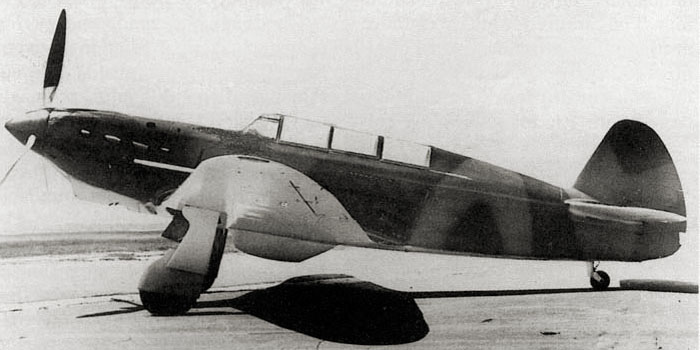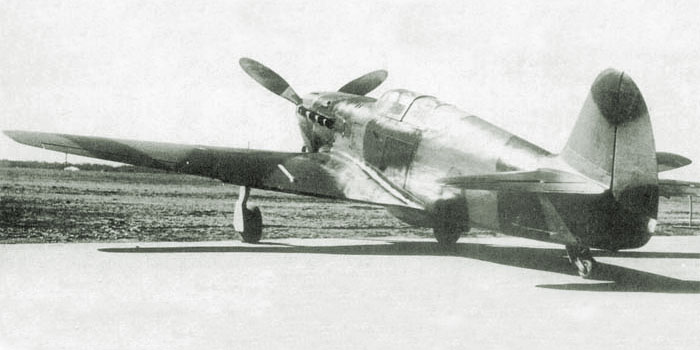Painting of newly-built Soviet warplanes, June 1941- September
1943
by Massimo Tessitori
|
Updated on September 21, 2013
In early 1941, the Air Force required the development of new matt paints. The
matt finish was obtained by adding talc and zinc stearate to the product, giving
origin to:
- AMT-x were nitrocellulose lacquers for mixed construction planes, that is,
they can be utilized on metal, wood and fabric;
- A-xx-m were matt oil-based paints for all-metal planes, introduced in 1941;
they had the same pigments of the corresponding AMT series, but the medium gave
to them a slightly more brownish-yellowish shade, visible on the light colors.
On May 6, 1941, a new directive ordered factories to deliver planes with disruptive
camouflage on upper surfaces and light grey undersurface. Disruptive camouflage
was intended not only to match the plane to the prevailing colors of the background,
but also to distort its shape and make its detection more difficult. The scheme
was not specified, and this directive was not immediately applied.

|
In the end of May, Stalin ordered a commission to trace
detailed instructions for camouflage schemes within 3 days.
The brief document included two schemes for black and green camouflage,
one for single-engined planes and one for twin-engined ones.
These schemes show the planes from above and from the left side, while
the right side was left to free interpretation.
The soft edges of the bands had relevance in the prevailing theories of
camouflaging. |
| |
These were influenced by the experiences of Yakovlev that had already
started to apply disruptive camouflage on his fighters, and probably proposed
his scheme.
Left, up:
UTI-26 of summer 1940
Left, down:
I-28 of late 1940
|
On 20 June 1941, the last day of peace, it was published an order to mask aircraft,
runways and airfield facilities; it was ordered to paint all planes with a new
standard camouflage within one month.
The new scheme was thought to minimize the cost of materials
and time. Existing planes with uniform green uppersurfaces had to be added with
matt black (A-26m oil paint for metal planes, and AMT-6 nitrocellulosic lacquer
for mixed construction planes). The directive said to repaint the upper and
side surfaces of silver and grey planes with two layers of green, and then to
add the black stripes. Nothing was written on undersurfaces of already existing
planes, that presumably preserved the original finish.
For newly built planes, the
instructions on painting said to utilize matt light blue for undersurfaces (not
specified what type of paint, but all previous light blue paintings were gloss,
so they have to be A-28m for all-metal planes and AMT-7 for mixed construction
planes). These instructions were given on June 23.
Apart for Yaks, the first
known photos of planes with the new green/black painting scheme are dated to
July 13, 1941.
Many maintenance manuals
of the first years of war describe these paints: dope
AMT-4 green, AMT-6 black and AMT-7 blue enamel or oil A-24m, A-26m and A-28m
of the same colours. Oil colors were less utilized, also because AMT colors
can adhere well to primed metal surfaces.
Those manuals didn't write
about other colors for the exterior of planes before 1943, only a quite rarely
used light-blue, red and white (for symbols) and aluminium (for the priming layer
of AMT dope).
Original
chips of many colors utilized during the war appear on the so-called Alboom Nakrasok
of 1948, released by the Ministry of Chemical Industry. It's arguable that colors
preserved in a library, far from moist and sun, are much better preserved than
colors found on wrecks faded by sun and are the most reliable source now available,
even if they could be not 100% representative of how they were 70 years ago.
Despite their name (M= matt),
AMT colors were semigloss when new, and turned to matt finish with ageing. Occasionally,
they could have been overpainted with a layer of gloss varnish AB-4-d to improve
aerodynamicity and gain some speed.
All the dopes were produced
in two versions with different viscosity: for painting by brush - with index
«to», and spray equipment - «p».
While AMT-4 and 6 were codified
in July 1941, AMT-7 was codified in August 1941, and is not mentioned on earlier
manuals; earlier AII light blue remained in use in parallel with the darker AMT-7
in the first years of war.
The oil enamels of similar
colours: A-24m (green), A-26m (black) and A-28m (blue) were made matt with the
addition of an additive that has his own film components, that turned the shades
to yellowish, particularly visible on light shades as A-28m that looks nearly
green. It's questionable if this was the look of fresh color, or if it would
have turned to yellow when exposed to sun. It's possible that its shade, when
fresh, was more similar to AII light blue than to AMT-7.
Oil enamels were intended
to be sprayed on the exterior metal surfaces, even unprimed. Painting with a
brush meant poor paint properties, and was allowed only as a second choice, ex.
for repairs.
It has to be noted that, in the chaos of late 1941,
these directive could have been not strictly applied, and stocks of old colors
could have been utilized aside the new ones. The chaos ended only at the beginning
of 1942, when new chemical plants for paints production were operative. Besides,
many depots of minerals for pigments were in Ukraine, now occupied by Germans,
so it was necessary to look for available alternatives.
In 1942, VIAM has developed
hard-inflammable chlorovinyl enamel colours: DD-118 (gray, for the internal surfaces),
HV-4 (green), HV-6 (black) and XT-7 (blue). In July, they were tested on Yakovlev
fighters. The project to introduce the new paints was started in August 1942,
but abandoned in 1943 because of industrial difficulties; chlorovinyl enamels
were widely diffused for wood/fabric parts only after the war's end.
The strong standardization of colors and camouflage
pattern was an advantage for production, but the predictability of the look
of planes mined the purpose of camouflaging. As a compromise, both on Yak and
Lavochkin fighters sometimes the black and green colors were exchanged between
them.
The order of June 1941 changed the national marks
of planes too. Red stars, of plan type or with thin black outline, were now
placed in six positions:
- one on each side of fuselage,
- one on each side of rudder/stabilizer,
- one on the undersurface of each wing.
Note the deletion of stars over the wings, and
the introduction of new ones on the tail.
Sometimes stars were outlined with white, silver
or yellow borders, but this wasn't a standard.
Numbers, of one or two digits, were usually painted
in white on the fuselage sides, even if they are sometimes seen on the rudder
or stabilizer.
Yak-1 |
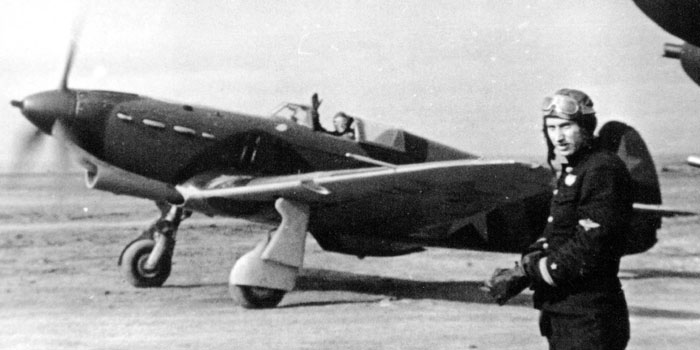
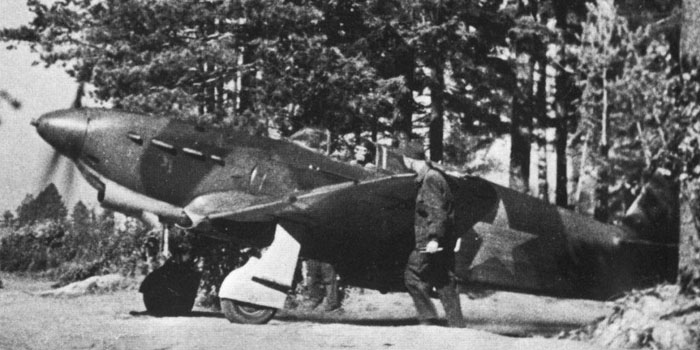
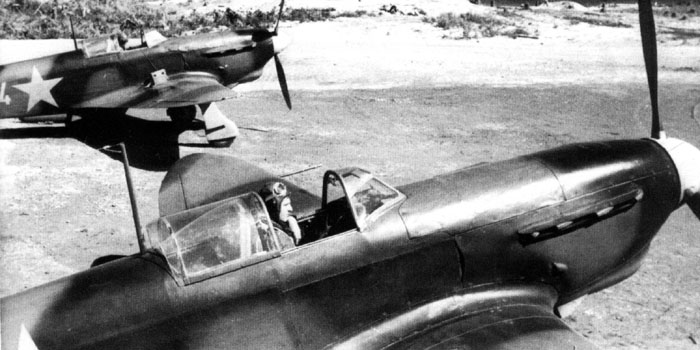
|
Yak-1 fighters factories introduced the standardized black/green
camouflage even before June 1941.
Left:
a photos above shows early Yak-1s with the standard camo pattern.
The second photo show an early Yak-1 with the reversed camouflage: green
and black bands were exchanged between them.
The third photo shows a Yak-1b, recognizable for its bubble canopy, in
1943. Its camouflage looks to follow accurately the NKAP standard scheme.
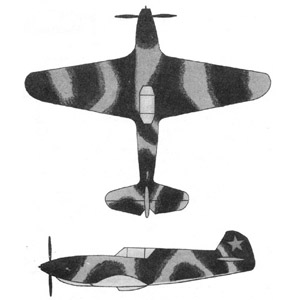
|
Yak-7
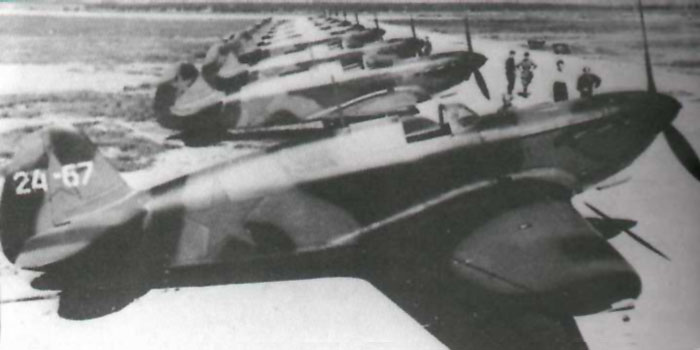

|
Yak-7s usually respected the standard template, with some variations
as for the 'loop' visible on the wings of the planes of the first photo.
This line of planes shows an high standardization of the pattern, that is
somewhat different from the NKAP template because of the 'loops' over the
wings.

The plane below shows another interpretation of the scheme.
|
Yak-9 |
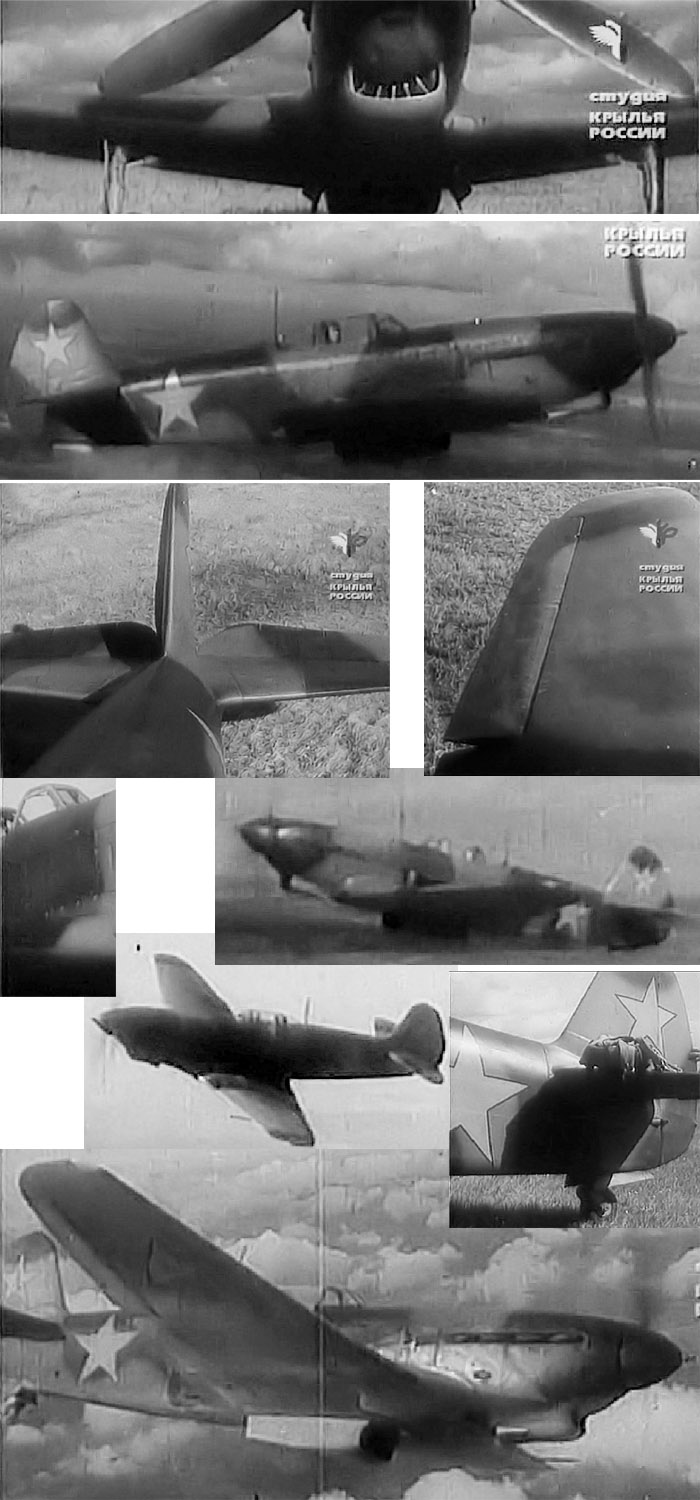
|
These images of a Yak-9 show another variation of the pattern, differing
not only for the loops on the wings but for the tail and the right side of
the rear fuselage, not drawn on the sketch of NKAP.
|
|
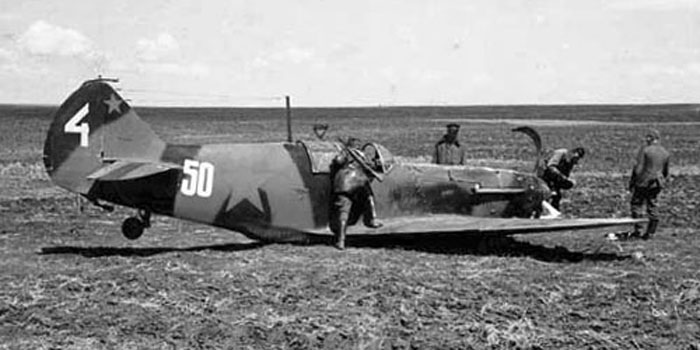
photo of early 4-50 LaGG-3 of 1941 with standard scheme.
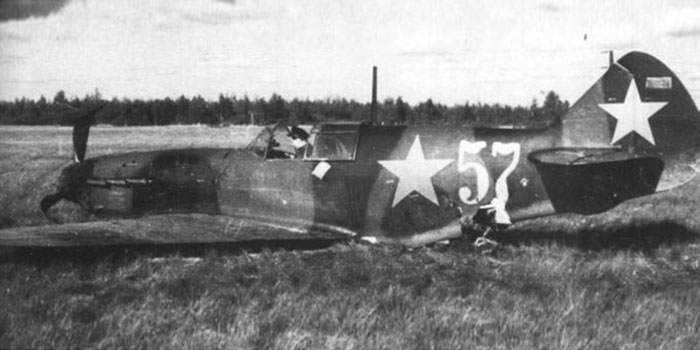
LaGG-3 of mid production (series 35) downed by Finns. Again, its painting
is fully standard.
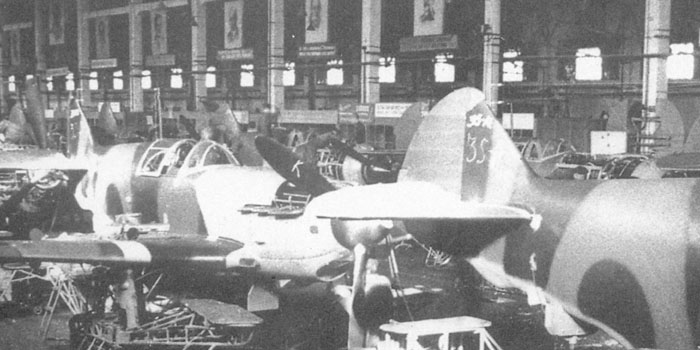
Factory where LaGG-3s and La-5s were produced in parallel in 1942. The
main body of the plane is painted before the engine cowling panels and other
parts. The light color on the cowling panels should be ALG-1 yellowish primer.
|
LaGG-3s produced after the war outbreak had a standardized camouflage
that respected well the NKAP template; the main difference was that LaGG
had usually three black bands (instead of two) on the right wing and two
(instead of three) on the left wing.
Bort numbers were painted in not standardized characters.

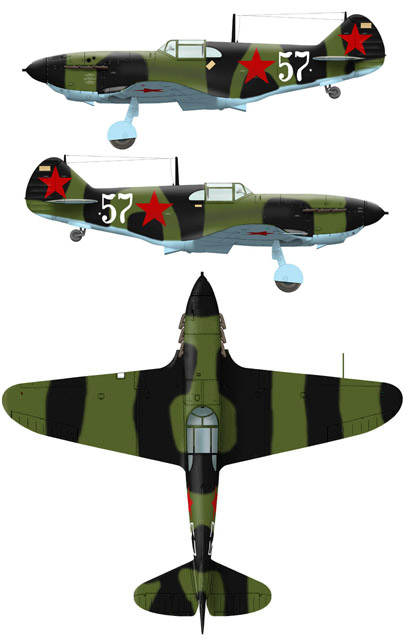
|
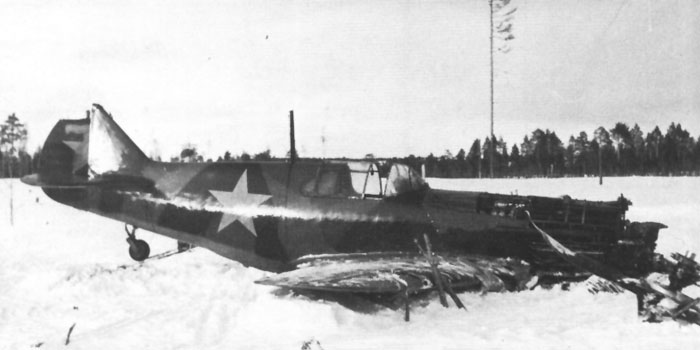 |
LaGG-3 silver 71, downed by Finns, shows two interesting characteristics:
the camo scheme is reversed, with green instead of black and vice versa; besides,
some brush-painted bands of a lighter camo color are vaguely visible on the
fuselage. There are both Russian and Finnish reports about the use of a third
color, a brighter green, on some planes. |
|
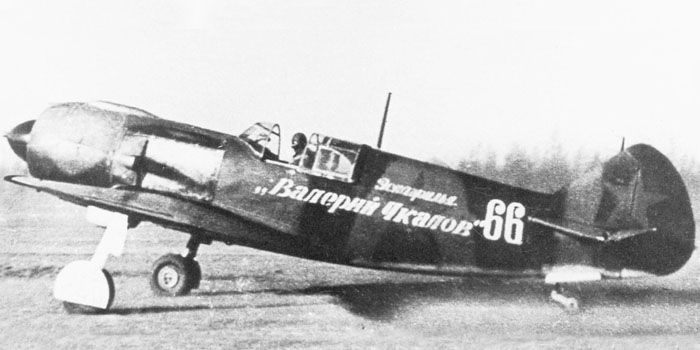

|
La-5, early La-5F and FN had the same camouflage of LaGG-3.
Bort numbers, always of two digits, were painted in standardized white
characters.
La-5 n.66 with the inscription 'eskadrilya Valeriy Chkalov on its side.
The camouflage is fully standard, apart for the lighter repainting on the
green of the cowling.
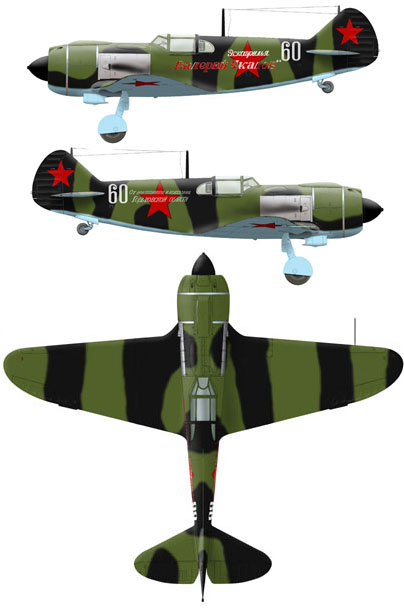
Right:
Photo of La-5F with the standard green-black camo and the inscription 'Eskadrilya
Valeriy Chkalow'. Only few La-5F left the production lines with this livery,
because they turned soon to the grey camo scheme of 1943/45. On the background,
a La-5 with the same painting is visible. |
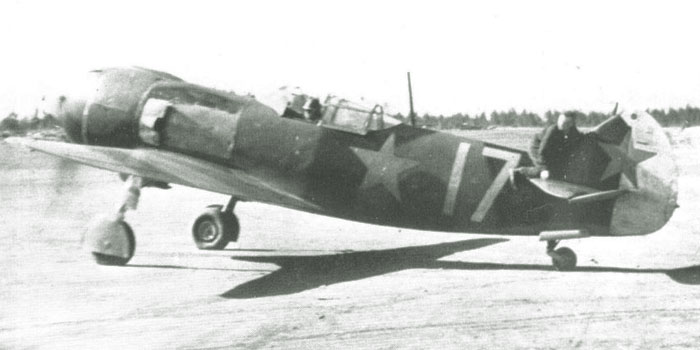 |
Another La-5F with the same camouflage, but the bort numbers are already
of large size, with thin dark outline, probably dark blue. |
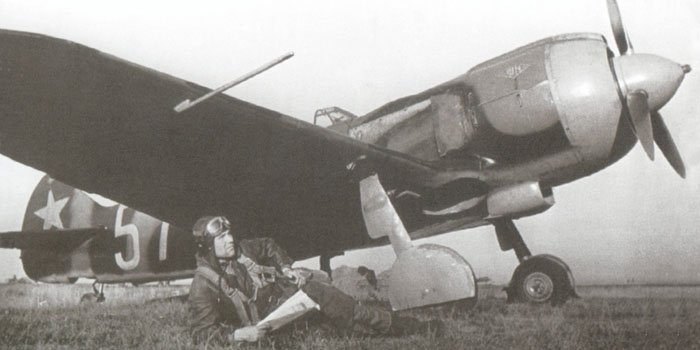
|
Very rare photo of La-5FN n.57 with green/black scheme and probably red
nose. About all La-5FN appear with the later grey/grey scheme.
The number is already standardized on the large size typical of later production
La-5FN and La-7, probably with thin dark blue outline. |
|
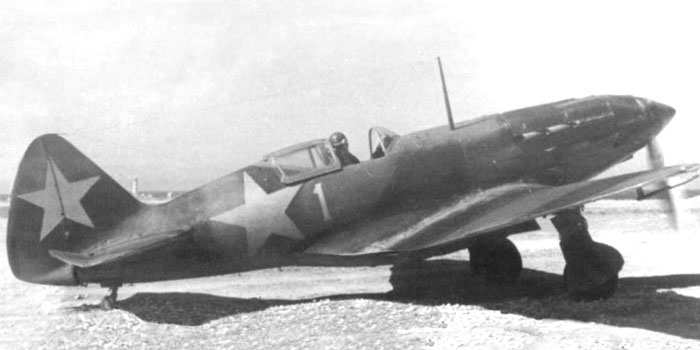
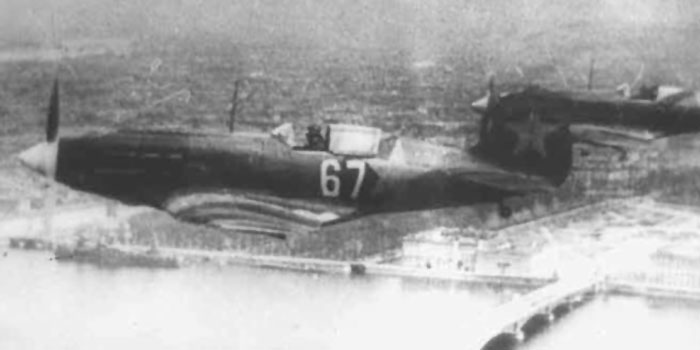
|
MiG-3s didn't follow accurately the standard template, but they have
a predominant factory scheme anyway, followed with many variations. This
is probably because the nose is longer than the Yak shown on the template
and requires one more green band, while the rear fuselage is shorter and
hasn't space for the black half-ball traced on Yaks.
The painting over the wings could sometimes be snake-shaped, but it's usually
made with nearly parallel band passing from the leading edge to the back
edge.
The contrast shown in photos is usually much lower than on Yaks and Lavochkins,
and this could be due to the use of a very thin layer of black over green,
that could have given the look of greenish black on many planes.
Sometimes MiG-3s cowling panels and spinners were painted black, perhaps
to improve the cooling of the engine by irradiation.

|
|
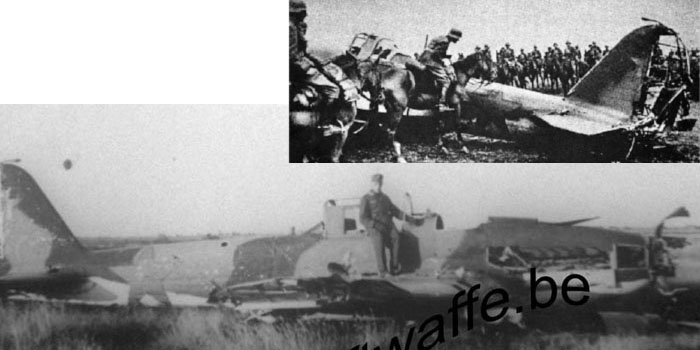
|
The camouflage of the Il-2s, both singleseaters and twoseaters, depends
on the factory, and is a distinctive characteristic that often allows
to understand where an Il-2 was built.
Just after the war outbreak, the camouflage was not standardized, but changed
much from plane to plane; probably this is particularly true for the planes
built after the war with green livery and updated by painting black bands.
This single-seater Il-2 shows a camo scheme different by that of the standard
template. Note the huge black-outlined star on the fuselage, and the smaller
one on its tail, that are very characteristics of planes (downed) in July-August
1941. |
 |
In the same period, many new-built planes followed accurately the NKAP
template, in a symmetrical interpretation with 'half-balls' on each side of
the rear fuselage. This pattern was used by Zavod 18 in July/August 1941,
on planes both with wooden and metal rear fuselage. |
 |
Around September 1941, the pattern of Zavod 18 evolved into a characteristic
black 'amoeba' on both the sides of the tail, a characteristic that remained
recognizable up to the summer 1943.
The left wing had often three longitudinal bands, while the right wing
had a black 'tree' with two or three branches reaching the leading edge and
one the back edge. The thin white outline around the stars was distinctive
of this factory. |
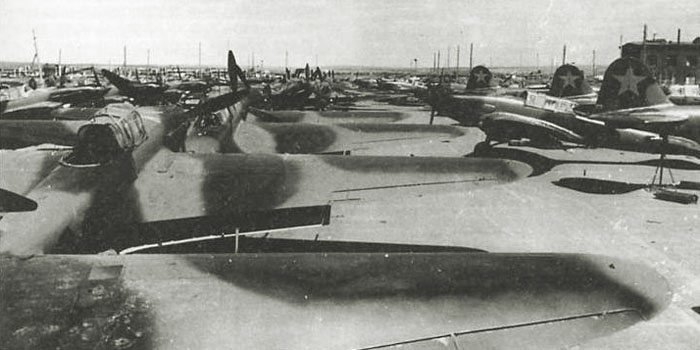 |
Zavod 1 had a characteristic pattern on the most part of its production,
without making difference between singleseaters and twoseaters.
A single known case of 'reversed' camouflage was seen on a photo of IL-2KR
(spot artillery plane) built by this factory. |
| 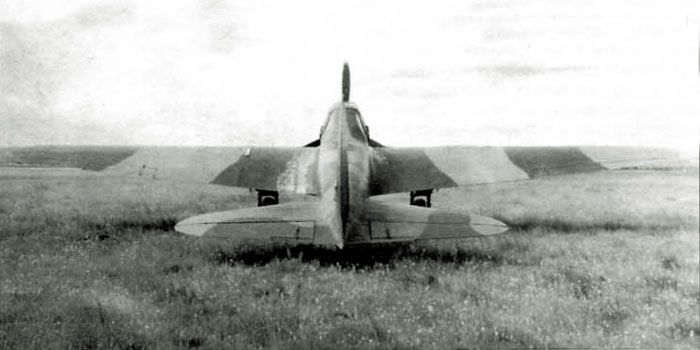
|
Il-2s built in Zavod 30 in Moscow resumed the NKAP template as those
built in Z.18 in July/August 1941.
This pattern has two main variants: one with a black 'half-ball' on each
side of the fuselage, under the stars, and another without the half-ball,
with a black band going from the tail to the mid of the rear fuselage.
To know much more, go to the Il-2 page |
|
 |
This plane is a Su-2 M-88 in artillery plane versions. Its black-green
camo scheme strictly resembles the standard template.
Unfortunately this is the only well-documented Su-2 with this scheme.
All other photos of Su-2 show patterns strongly changing from plane to
plane, and it's impossible to trace a standard pattern or extrapolate
anything of the painting of a plane from photos of other ones. |
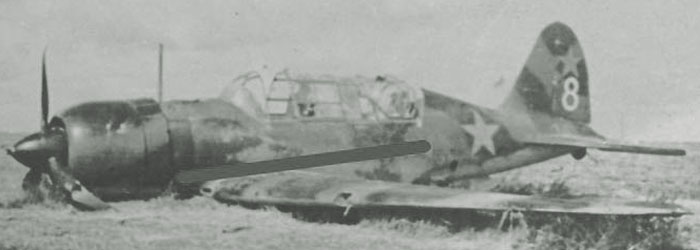
|
|
|
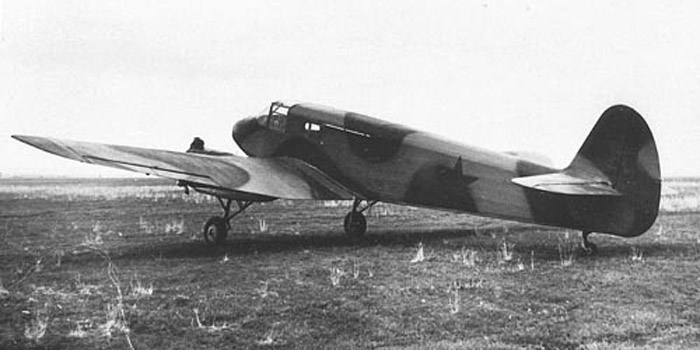
|
The very first camouflage scheme of the Yak-6 was black and green, in
full coherence with the use of 1942
.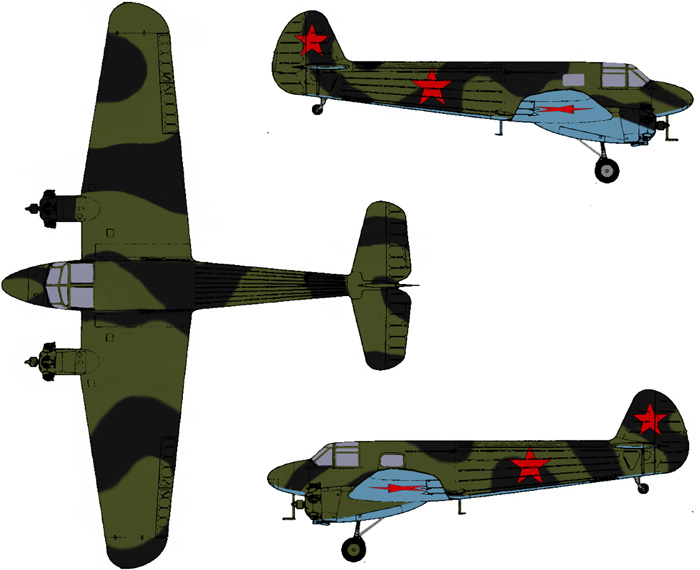 |
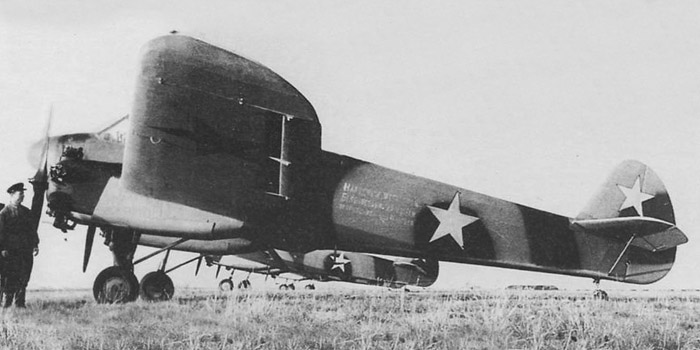
In bw photos, this camouflage resembled as the black-green one, also because
the contrast between the AMT-4 green and the third color (probably AMT-1
light brown in an early, greyish variant) is very low. In most cases, the
lighter color seems to replace part of the green of a previous 2 shades camo
without covering the black part.
There are photos showing an 'inverted' camo where black replaces the green
and vice versa, and again part of the green is replaced by the lighter shade.
To know more, go to the Yak-6 page. |
According to photographic records, the vast majority of Yak-6 operative
after the fall of 1942 bore a 3 shaded camouflage, much before this was officialized
by NKAP in July 1943.
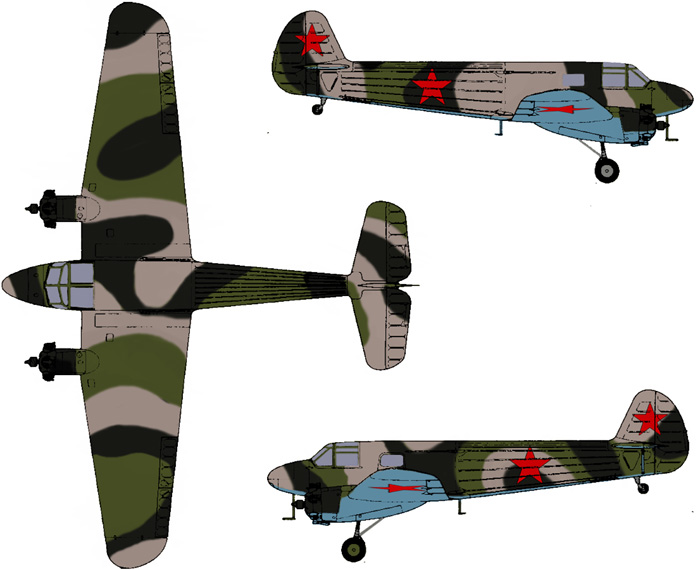
|
|
| These images shows well the standard black-green camo scheme of Pe-2s
of 1941-43. Some planes had sharp bands, some other ones blurred, but
the good standardization of the pattern is evident.
The pattern can be considered a reinterpretation of the standard template
where the side 'half-balls' are transformed into a band passing over the
fuselage. The black paint of the spinner could extend briefly over the engine
cowlings. The upper camouflage could extend more downward on the cowling
sides.
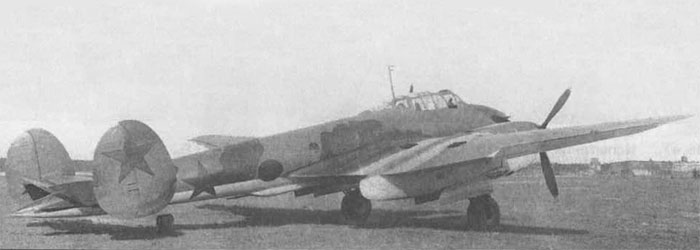
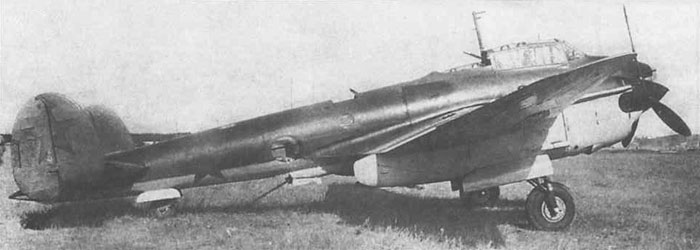
To know more, go to the Pe-2/Pe-3 page. |
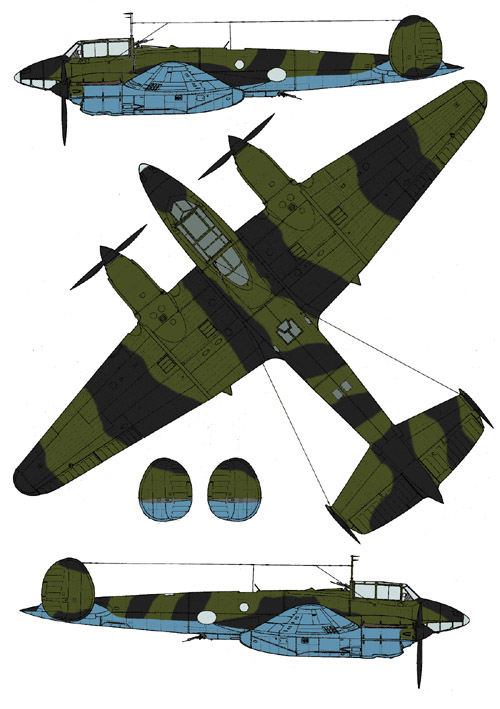
|
|
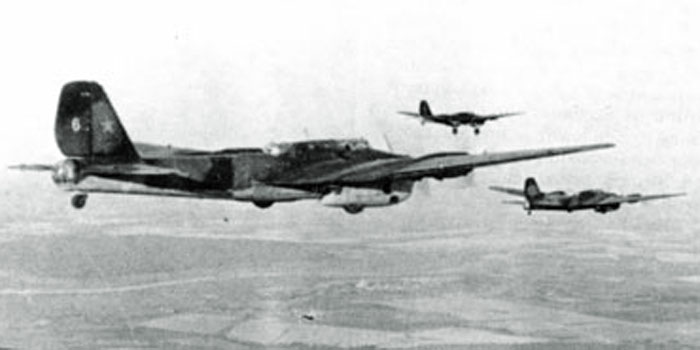
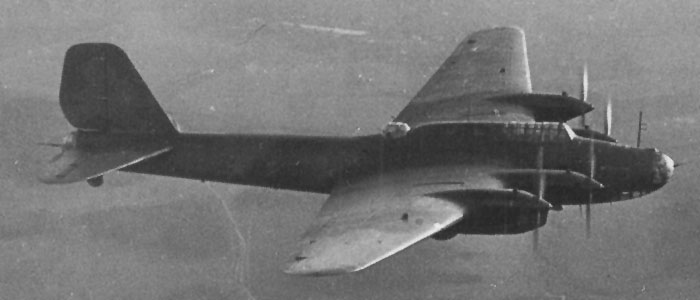
About the colors: theoretically, metal parts were painted with
oil paints: green A-24m, black A-26m and light blue A-28m, while the fabric-covered
parts of control surfaces were painted with the equivalent nitro paints green
AMT-4, black AMT-6 and light blue AMT-7 (or AII light blue).
Observing wartime photos, my impression is the lack of discontinuity of
the shades and bands between the metal-skinned parts and the fabric-skinned
control surfaces suggests that the nitro colors were employed for all the
surfaces of many planes.
In 1942/43, the undersurfaces of the planes were repainted with 'noch'
deep black for night operations.
To know more and see lots of images of TB-7/Pe-8, click here. |
In 1941/43, Pe-8s were camouflaged with a variant of the 1941 template
of NKAP, adapted for the major size of the plane with some more black bands
both on fuselage and on the wings. The pattern was roughly standardized.
These images allow to compare the resemblances and differences between
some planes of the same type.
Here is the template that I obtained from photos, taking into account the
variability between single planes. It fits enough the sketch of NKAP. The
main differences between single planes were about the extension of black
to the engine cowlings, or not.
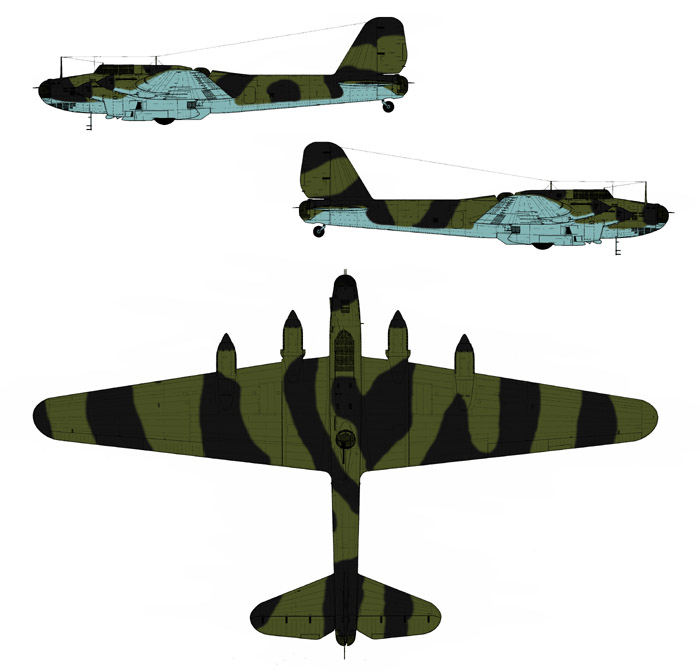
|
|
Il-4s were all-metal planes, so they were finished with oil paints
A-24m green, A-26m black and A-28m light blue, except for the rudder
and elevators that , being fabric-skinned, were finished with AMT-4
green, AMT-6 black and AMT-7 or AII light blue.
Discontinuities of the camouflage
are visible between these parts and the metallic parts of the tail, so wide
and usual that can be considered a standard.
At the beginning of the war, the undersurfaces of Il-4s were finished in
light blue, but in 1942/43 they started to be painted with Mk-8 or 'Noch',
that was darker than the black paints utilized for the upper camouflage.
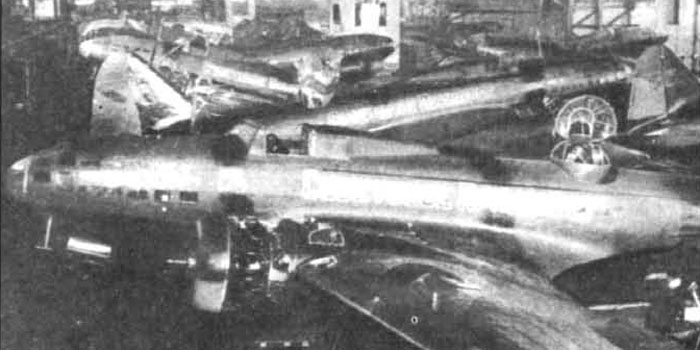
Green-nosed Il-4s in factory. Undersurfaces are light blue. Note the discontinued
camouflage on the rudders.

Green-nosed Il-4 with 'noch' undersurfaces, clearly darker than the black
of camouflage.
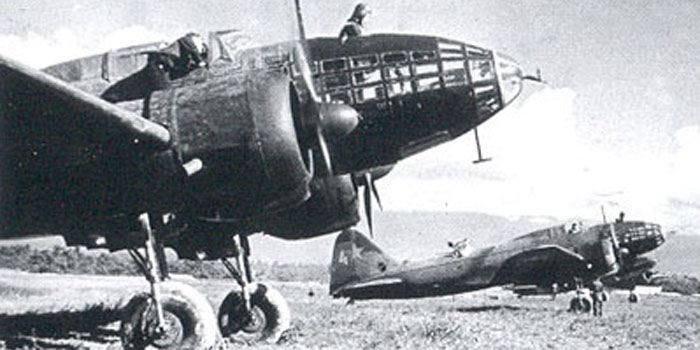
Black-nosed Il-4s. Note the discontinuities in the painting of rudder.
Red stars on the tail and fuselage were relatively small and usually of
the plain type; often the stars on fuselage were missing.
To see lots of photos and drawings, go to the
Il-4 page |
The camo scheme for 1941-43 Il-4 is standardized into two variants; probably,
each one is relative to a factory where the type was built.
1- green- nose, characterized by a large black band on the rear fuselage;
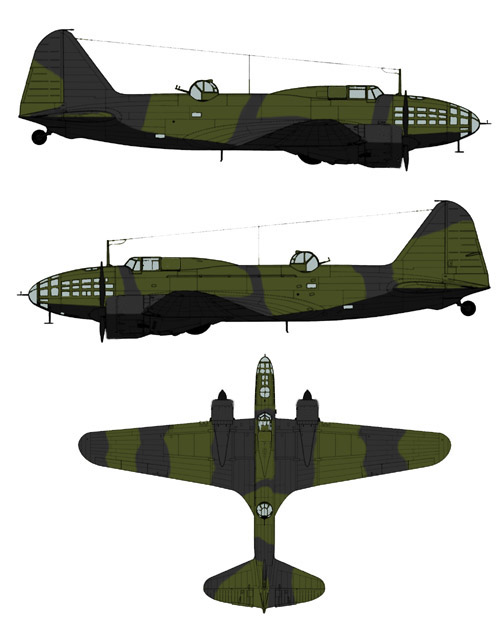
2- black nose, with a fully green rear fuselage and wing root black
bands extended on the sides, and often with green engines. Sometimes,
the black bands on wing roots extends to the engines or up till behind
the canopy.

Note that these patterns are not respected by planes built before the war
outbreak, even when they were repainted with the black-green camouflage.
|
Yer-2
|


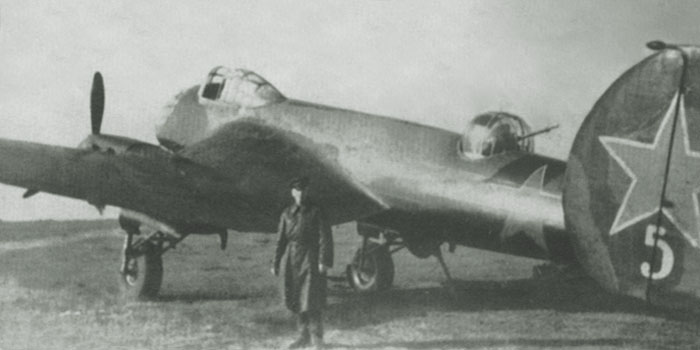
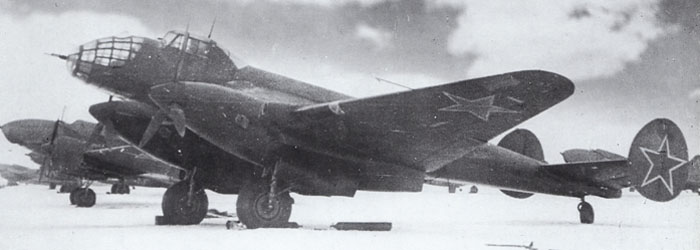
|
Yer-2s 2M-105 were all-metal planes, so they should have been finished
with oil paints A-24m green,
A-26m black and A-28m light blue, except for the rudder and elevators that,
being fabric-skinned, were finished with AMT-4 green, AMT-6 black and AMT-7
or AII light blue.
The semiglossy look of the
planes on some photos and the absence of discontinuities in the camouflage
of the movable surfaces suggest that the nitro paints were employed on all
the external surfaces.
At the beginning of the war, the undersurfaces Yer-2s were finished in
light blue, but in 1942/43 they started to be painted with Mk-8 or 'Noch',
that was darker than the black paints utilized for the upper camouflage.
The pattern of the camouflage is standardized, and very similar to that
employed on Pe-2s.
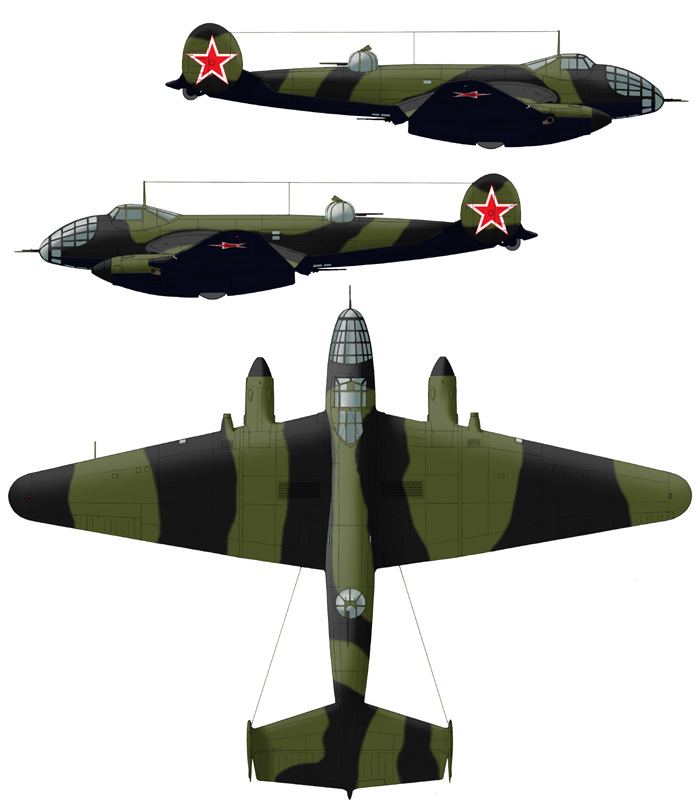
This template, although provisionally traced on a drawing of the late Yer-2
with ATch-30B engines, is well representative of the earlier version with
2M105 and asymmetric cockpit.
To know more, go to the Yer-2 page |
|
The first production Tu-2 ( VS and S) were completed in February 1942
in factory 168 in Omsk.
On October 1942, it was ordered to stop the production, and the 80th and
last plane was delivered in January 1943.
The production of Tu-2 was restarted in July/August 1943 at Factory n.23
in Moscow with the improved Tu-2S

Tu-2VS n. 100716 in standard black-green livery utilized in 1942. Note
the white or silver outlined star on the tail, and the lack of stars on fuselage
(present on some other planes). |
On the whole, the template of early Tu-2 of 1942 resembles very much
the standard one for Pe-2s.
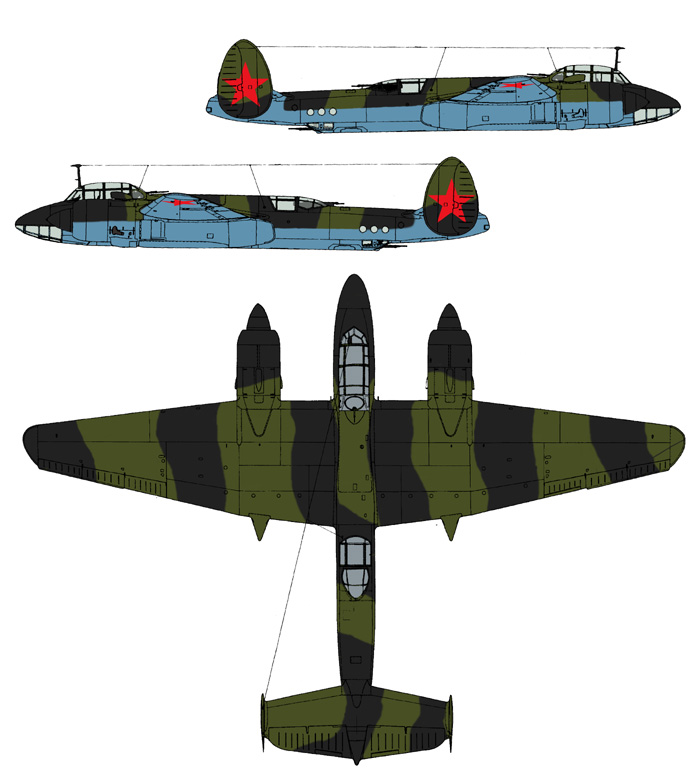
Some photos and drawing suggest the existence of a reverse pattern, where
green replaced black and vice versa, but their interpretation is questionable.
To know more, go to the Tu-2 page |
|
| 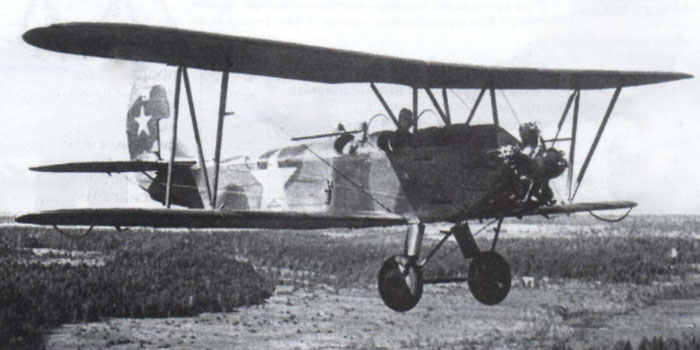
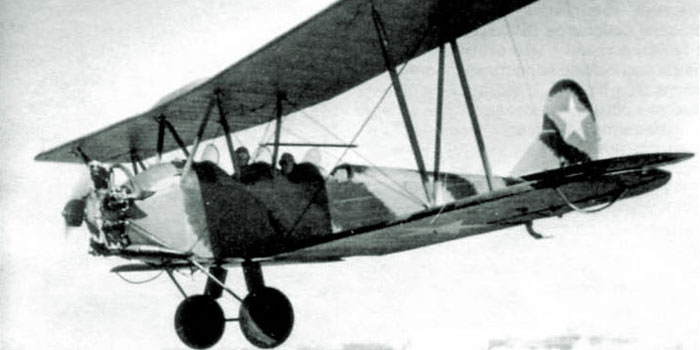
|
Being U-2 a mixed construction plane, the standard black-green camouflage
was made with nitro paints: AMT-4 green. AMT-6 black and AMT-7 light
blue, or AII light blue.
From a preliminary examination of available images, it seems that Po-2s
camouflages were standardized on two different patterns: one characterized
by nearly symmetrical 'half-ball' bands on the fuselage sides (first photo),
and one by oblique bands that cut the fuselage sides in all their vertical
extension (second photo). |
|
| 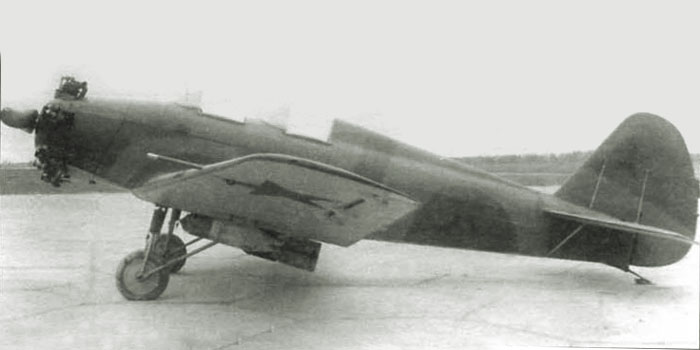
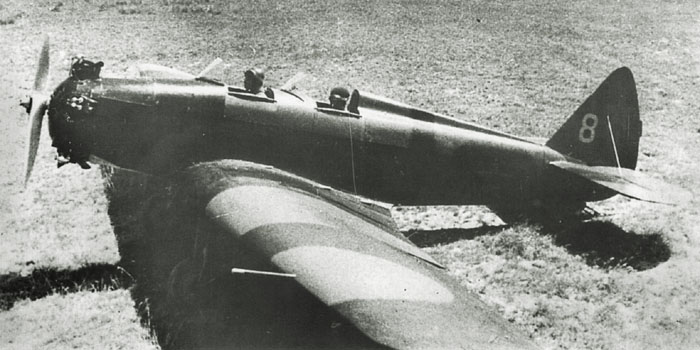
|
The UT-2M was put into production in 1941; it differed from earlier
UT-2 mainly because of the adoption of an arrow wing and a wider stabilizer/rudder
that gave to the new version better and safer flight characteristics.
Being a mixed-construction plane, the UT-2M was painted with nitro paints
AMT-4 green, AMT-6 black and AMT-7 blue (or AII light blue).
Known photos of UT-2M show a good conformity of their pattern to the template
of 1941.
|
|
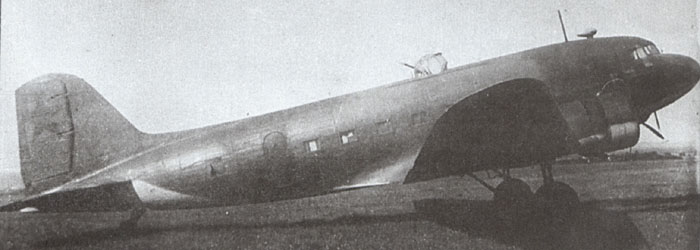
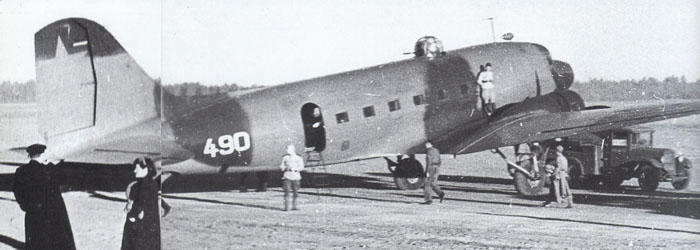
|
Li-2s of 1941-43 look to conform to a main template with green background
and large bands of black: one on the upper part of tail, one on the rear
fuselage, one on all the aft fuselage. Red stars are always visible on the
rudder, while their use on the fuselage side is optional.
A variant of the camo pattern features four transversal bands on the tail
and fuselage.
To know more, go to the Li-2 page. |
Camouflage paints for Soviet aircraft June 1941-September
1943
| name of paint |
indicative chip |
match |
typical use |
notes |
AMT-6
matt black |
 |
FS-27038 (2,3) AKAN 343 |
black-green camouflage of mixed construction
planes (Yak-1,7,9, LaGG-3, La-5, MiG-3, Il-2, Su-2, U-2, mixed-construction
Il-4, Pe-2...) |
Nitrocellulose lacquer for mixed construction planes |
A-26m
matt black |
 |
FS-37038 (2,3) AKAN 343 |
black-green camouflage of all-metal planes
(Pe-2, Pe-8, all-metal Il-4...) |
Oil paint for all-metal planes
equivalent to AMT-6 |
AMT-4
matt camouflage green |
 |
FS-24102, 24151 (2,3) AKAN 301 |
black-green camouflage of mixed construction
planes (Yak-1,7,9, LaGG-3, La-5, MiG-3, Il-2, Su-2, U-2, mixed-construction
Il-4, Pe-2...) |
Nitrocellulose lacquer for mixed construction planes |
A-24m
matt camouflage green |
 |
FS-34102, 34151 (2,3) AKAN 301 |
black-green camouflage of all-metal planes
(Pe-2, Pe-8, all-metal Il-4...) |
Oil paint for all-metal planes
equivalent to AMT-4 |
AMT-7
matt greyish blue |
 |
FS-25190 AKAN 302 |
Undersurfaces:
of mixed construction planes (Yak-1,7,9, LaGG-3, La-5,
MiG-3, Il-2, Su-2, U-2, mixed-construction Il-4, Pe-2...) |
Nitrocellulose
lacquer for mixed construction planes, in use after 1941. |
A-28m
matt greyish blue |
 |
new FS-34533 (1,6)
aged FS-34533 (2,3) |
Undersurfaces
of
all-metal planes (Pe-2, Pe-8, all-metal Il-4...) |
Oil
paint for all-metal planes equivalent to AMT-7 or AII light blue.
The sample on the Nakrasok Alboom appears yellowish, similar to British
Sky, but the chip of A-28g, its gloss equivalent, is much more bluish.
|
AII Sv.gol. (svetlo goluboi)
gloss light blue |
 |
AKAN 342 |
Undersurfaces
of mixed construction planes in alternative to AMT-7
|
Nitrocellulose
lacquer
Specification issued around 1937; in use after June
1940; continued to be used in parallel with AMT-7 in the first years of war. |
MK-7, MK-7f, Mk-7Sh
very matt white |
 |
|
1941-1943 winter camouflages |
water soluble distemper, removable |
MK-6
matt black |
 |
(1) |
undersurfaces of night bombers |
1941
water soluble distemper, removable, darker than AMT-6
|
MK-8 and “Noch” (night)
matt black |
 |
(1) |
undersurfaces of night bombers |
1942 -1945
permanent, darker than AMT-6 |
Note: AMT colors are usable on all-metal planes too, if sprayed over
an ALG-1 primer.
Some notes on the green/black camouflage
The idea that Soviet planes of 1941/43 were all, or nearly all, painted with
black/green camouflage has prevailed only in last ten or fifteen years thanks
to historical documents and exhibits.
| |
In past years, the standard camouflage of fighters has been interpreted
as green and dark red-brown, or dark green/dark earth as British planes.
Although this camouflage found a great credit in books illustrations, kits
instructions sheets and even in restoring planes in museums, it seems that
this livery never existed: none wreck and originally-painted museum exhibit
shows this, nor is described in official documents on painting wartime planes,
nor is known a dark red-brown suitable to match these schemes in the VVS
inventory.
A 'tobacco' paint was experimentally produced in late 1940/early 1941,
but it's not mentioned in any directive to camouflage planes, so it's likely
that it was never utilized, if not for some test planes.
How was the legend of green and red brown born? Difficult to say. It is
ancient, because I remember a green/red brown drawing already on the blister
of the Yak-9 of Airfix in the late '60s. Probably, some artist heard from
recalls of veterans that some Soviet planes were green and brown, had a look
to b/w photos showing black/green planes, compared them to all-green planes
and concluded that the brown had to be the darker color. Let's admit this,
the use of black on camouflages is not so intuitive, particularly if this
black is not as dark as usual black and looks some other dark color. |
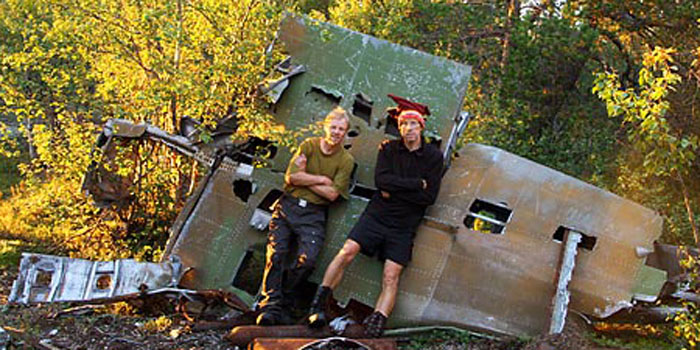 |
Some wrecks could have helped the legend of dark brown. For example, this
photo of a wrecked wing of Il-2 gives really the idea of a dark green/dark
earth camouflaged plane. The small and faded grey blotch can easily
pass unobserved. Weathering has inverted the real contrast between colors
if compared to their original shades, when the grey was the darker one
and the brow the lighter one.
This doesn't mean necessarily that none Soviet plane was ever painted with
red brown bands, it would be impossible to demonstrate this, but simply that
there is not any reason to think that this color was utilized.
It can't be excluded that some planes wear a two-color camouflage of green
AMT-4 and light brown AMT-1, without the dark grey AMT-11 that should be
associated to them by the three-shades after-1943 standards; however, this
is still object of controversy. I's noteworthy that often AMT-4 and 11 are
undistinguishable on bw photos, and when they are distinguishable it's controversial
which one is the darker.
|

|
Green/dark green camouflage was proposed by some authors. How does this
comply with available documents?
At present time, there are not documents proving this use, even if a lot
of photos of planes show so low-contrasted camouflages that it's hard
to believe that the darker color is black.
However, the look of photos can be influenced by many factors as the type
of film, the light, the exposure, the preservation of colors and the use
of filters on the objective of the camera.
Here are four photos of LaGG-3 n.57 captured by Finns. Despite being relative
to the same plane, note how the colors are represented with different contrast;
this could encourage discordant interpretation on colors, and even on the
presence of the red stars.
Even if AII dark green, proposed by some authors, looks not confirmed by
any document, the occasional use of different shades of green, taken
from the inventory or obtained by mixing colors, can't be completely
excluded.
Some veterans have described camouflages with different shades of green,
dark green or black green. They could be wrong, but we can't be sure of this.
However, the overposition of a thin layer of black to a green background
could give the impression of a green/black-green camouflage to a witness. |
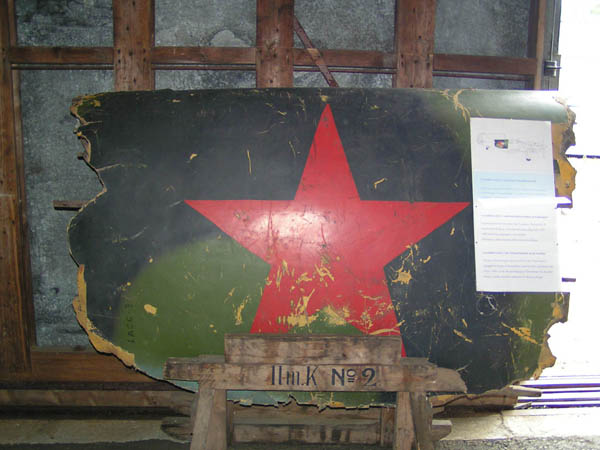 |
A section of fuselage from a LaGG-3 preserved in a Finnish
museum.
Here we can see the camouflage made with not too faded AMT-4, 6 and 7,
and the plain star painted with gloss AII red.
The yellowish color is of the underlying nitro putty.
(Image courtesy of Martti Kujansuu)
Below: a b/w version of the same photo, showing the poor contrast between
colors.
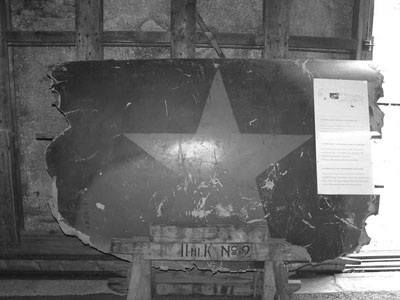
|
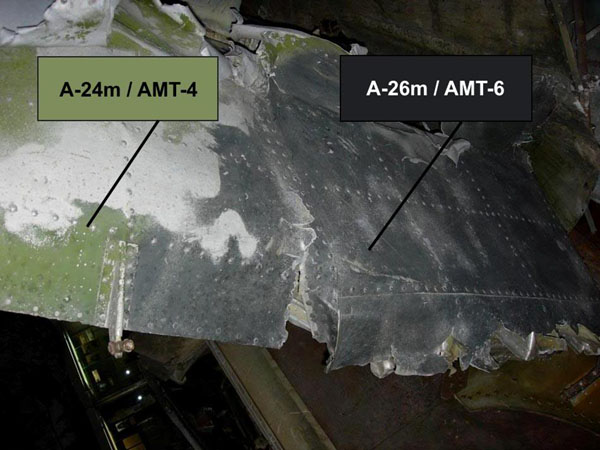 |
This piece of metal wing from a two-seater Il-2 shows a black/green
camouflage .
No any yellow primer is visible under the camouflage paints, so it's likely
that they are A-24m and A-26m oil paints, because AMT nitro lacquers
would have required a primed background to adhere on metal surfaces.
(color labels by Konstantin Lesnikov)
Below: a b/w version of the same image showing the poor contrast between
weathered colors.
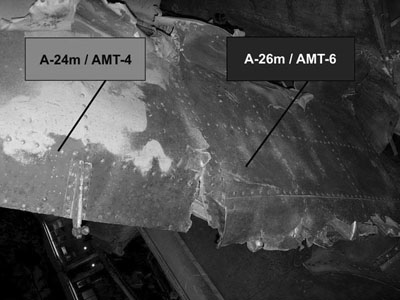
|
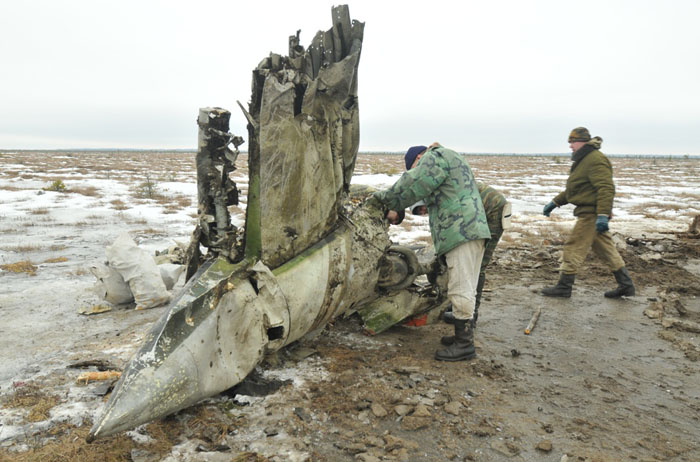 |
This image is from a wreck of a Pe-2 lost in september 1941 near Leningrad.
Note the surprising grey undersurface.
http://trizna.ru/forum/viewtopic.php?f=27&t=31223
|
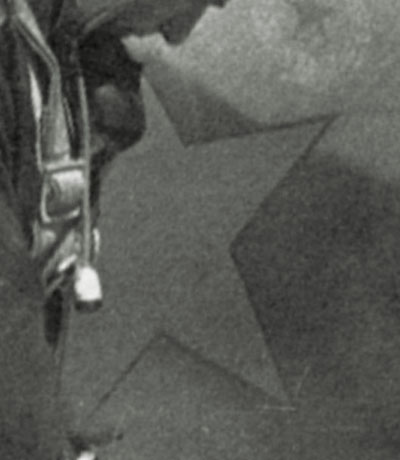 |
The AMT-6 black and A-26m utilized for camouflages weren't as dark as the
black utilized for the outlines of the red stars and other markings (not known
if 'T' or another nitro equivalent of A-12). In facts, on this Yak-7 we can
distinguish the black outline of the star even on the black camo band. |
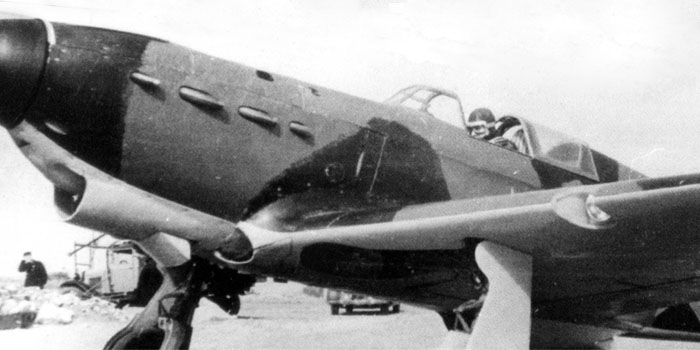 |
Many Yaks seem to show a particularly high-contrasted camo. The reason
of a so high percentage of contrasted images, when compared to other types
that hardly show contrast in photos, is unclear.
Someone suggested the use of a lighter shade of green (ex. tractor green)
or desert-style camos, but there is no any confirmation of this in documents
and exhibits, even if it is fully compatible with some photos.
Besides, in Nakrasok alboom of 1948 there is no any chip of green for agricultural
equipments compatible with the supposed shade.
The use of only one layer of green (instead of two) on a yellowish
background and, on the other side, the sharp edges and the semiglossy
finish of the black bands could help to explain this high contrast. |

